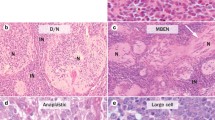Abstract
Medulloblastoma (MB) is the most common malignant brain tumor in pediatric age group. It is an embryonal tumor which is assigned WHO grade IV. It is a tumor of posterior fossa which arises in the cerebellum and rarely from brain stem. Histologically, MB is characterized by small, blue, round or carrot shaped poorly differentiated cells with scant cytoplasm and hyperchromatic nuclei with high proliferative indices. The histological subtypes include classic, which is the most common, followed by desmoplastic/nodular, predominantly seen in infants and adults, large cell/anaplastic and rarely medulloblastoma with extensive nodularity which is exclusively seen in infants. At the molecular level, MB clusters into four principal groups: WNT/Wingless activated, SHH/Sonic Hedgehog activated, Group 3, and Group 4. These groups have apodictic differences, not only at genetic, transcriptomic, and epigenetic levels but also differ in demographics and clinical profiles including patient outcomes. WNT tumors have the best prognosis while Group 3 have the worst outcomes. Recent advancements have led to identification of subgroups within groups, relevant in SHH and non-WNT/non-SHH tumors. The molecular classification has led to better and improved risk stratification of MB patients. Many clinical trials are underway to tailor therapy according to risk stratification and use of personalized targeted therapy.
Access this chapter
Tax calculation will be finalised at checkout
Purchases are for personal use only
Similar content being viewed by others
References
Ellison DW, Eberhart CG, Pietsch T. Embryonal tumors. In: Louis DN, Ohgaki H, Wiestler OD, Cavenee WK, editors. WHO classification of tumors of the central nervous system, Revised. 4th ed. Lyon: IARC; 2016. p. 184–200.
Capper D, Jones DTW, Sill M, et al. DNA methylation-based classification of central nervous system tumours. Nature. 2018;555:469–74.
Taylor MD, Northcott PA, Korshunov A, et al. Molecular subgroups of medulloblastoma: the current consensus. Acta Neuropathol. 2012;123:465–72.
Waszak SM, Northcott PA, Buchhalter I, et al. Spectrum and prevalence of genetic predisposition in medulloblastoma: a retrospective genetic study and prospective validation in a clinical trial cohort. Lancet Oncol. 2018;19:785–98.
Louis DN, Perry A, Burger P, et al. International society of neuropathology-Haarlem consensus guidelines for nervous system tumor classification and grading. Brain Pathol. 2014;24:429–35.
Ellison DW, Dalton J, Kocak M, et al. Medulloblastoma: clinicopathological correlates of SHH, WNT, and non-SHH/WNT molecular subgroups. Acta Neuropathol. 2011;121:381–96.
Phillips CL, Miles L, Jones BV, et al. Medulloblastoma with melanotic differentiation: case report and review of the literature. J Neuro-Oncol. 2011;103:759–64.
Rajeshwari M, Kakkar A, Nalwa A, et al. WNT-activated medulloblastoma with melanotic and myogenic differentiation: report of a rare case. Neuropathology. 2016;36:372–5.
Kool M, Korshunov A, Remke M, et al. Molecular subgroups of medulloblastoma: an international meta-analysis of transcriptome, genetic aberrations, and clinical data of WNT, SHH, Group 3, and Group 4 medulloblastomas. Acta Neuropathol. 2012;123:473–84.
Perreault S, Ramaswamy V, Achrol AS, et al. MRI surrogates for molecular subgroups of medulloblastoma. AJNR Am J Neuroradiol. 2014;35:1263–9.
Kaur K, Kakkar A, Kumar A, et al. Integrating molecular subclassification of medulloblastomas into routine clinical practice: a simplified approach. Brain Pathol. 2016;26:334–43.
Kaur K, Kakkar A, Kumar A, et al. Clinicopathological characteristics, molecular subgrouping, and expression of miR-379/miR-656 cluster (C14MC) in adult medulloblastomas. J Neuro-Oncol. 2016;130:423–30.
Northcott PA, Shih DJ, Peacock J, et al. Subgroup-specific structural variation across 1000 medulloblastoma genomes. Nature. 2012;488:49–56.
Remke M, Hielscher T, Northcott PA, et al. Adult medulloblastoma comprises three major molecular variants. J Clin Oncol. 2011;29:2717–23.
Ramaswamy V, Remke M, Bouffet E, et al. Recurrence patterns across medulloblastoma subgroups: an integrated clinical and molecular analysis. Lancet Oncol. 2013;14:1200–7.
Shih DJ, Northcott PA, Remke M, et al. Cytogenetic prognostication within medulloblastoma subgroups. J Clin Oncol. 2014;32:886–96.
Ramaswamy V, Remke M, Bouffet E, et al. Risk stratification of childhood medulloblastoma in the molecular era: the current consensus. Acta Neuropathol. 2016;131:821–31.
Bautista F, Fioravantti V, de Rojas T, et al. Medulloblastoma in children and adolescents: a systematic review of contemporary phase I and II clinical trials and biology update. Cancer Med. 2017;6:2606–24.
Robinson GW, Orr BA, Wu G, et al. Vismodegib exerts targeted efficacy against recurrent sonic hedgehog-subgroup medulloblastoma: results from phase ii pediatric brain tumor consortium studies PBTC-025B and PBTC-032. J Clin Oncol. 2015;33:2646–54.
Kaur K, Jha P, Pathak P, et al. Approach to molecular subgrouping of medulloblastomas: comparison of NanoString nCounter assay versus combination of immunohistochemistry and fluorescence in-situ hybridization in resource constrained centres. J Neuro-Oncol. 2019;143:393–403.
Cavalli FMG, Remke M, Rampasek L, et al. Intertumoral heterogeneity within medulloblastoma subgroups. Cancer Cell. 2017;31:737–54.e6.
Sharma T, Schwalbe EC, Williamson D, et al. Second-generation molecular subgrouping of medulloblastoma: an international meta-analysis of Group 3 and Group 4 subtypes. Acta Neuropathol. 2019;138:309–26.
Author information
Authors and Affiliations
Editor information
Editors and Affiliations
Rights and permissions
Copyright information
© 2021 The Author(s), under exclusive license to Springer Nature Singapore Pte Ltd.
About this chapter
Cite this chapter
Kaur, K., Sarkar, C. (2021). Pathology and Molecular Biology of Medulloblastoma. In: Mallick, S., Giridhar, P., Rath, G.K. (eds) Evidence based practice in Neuro-oncology. Springer, Singapore. https://doi.org/10.1007/978-981-16-2659-3_6
Download citation
DOI: https://doi.org/10.1007/978-981-16-2659-3_6
Published:
Publisher Name: Springer, Singapore
Print ISBN: 978-981-16-2658-6
Online ISBN: 978-981-16-2659-3
eBook Packages: MedicineMedicine (R0)




